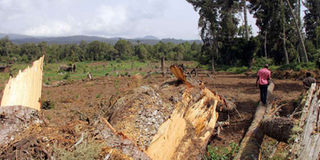Concerns raised as KFS permits harvesting of forest trees

This image taken on January 16, 2018 in Mt Kenya Forest shows the effects of commercial logging. PHOTO | NICHOLAS KOMU | NATION MEDIA GROUP
What you need to know:
- Environmentalists have started campaigns against the logging, accusing KFS of complacency in enforcing its mandate of protecting forests.
- An online petition has been initiated, seeking 5,000 signatures to compel the ministry of Environment and Natural Resources to stop the felling of trees.
A row has emerged between conservationists and the Kenya Forest Service over a system that allows commercial logging and farming in forests.
The logging by the government targets mature exotic trees, which are more than 25-years-old.
People living next to the forests are then allowed to farm the cleared land and given tree seedlings to plant, which they take care of together with their crops.
This programme, first introduced in the 2000s and called ‘shamba system’, has elicited concern and protests alike from environmentalists, who feel it does more harm than good.
In recent months, the number of trucks ferrying logs from Mt Kenya and Aberdare forests has increased.
The destruction has been blamed for the drying up of rivers in the region with deadly consequences.
CONSERVATION
Environmentalists have started campaigns against the logging, accusing KFS of complacency in enforcing its mandate of protecting forests.
“It makes no sense for the government to be destroying the forests in the name of supplying timber to the country.
"Rivers are drying up from the source yet KFS still allows logging for money. Their mandate is to protect forests not destroy them,” Mr Muchiri Mwangi, an environmentalist, said.
A recent assessment by the Saturday Nation in Mt Kenya Forest revealed that most rivers deep in the woods have dried up.
They are mostly tributaries of the Sagana and Tana rivers.
LOGGING
Logging has been ongoing in the forest for the last six months targeting trees aged up to 56- years-old.
Most of the logging has been happening in the Kabaru section of Mt Kenya Forest, where the KFS insisted the trees affected were over mature and had been scheduled for felling legally.
In the last one year, KFS has earned more than Sh37 million from the sale of trees.
“There is ongoing commercial plantation forest harvesting taking place in several gazetted forests in Kenya.
"Harvesting strictly adheres to felling plans that are approved by KFS board of directors on an annual basis,” the service said in a statement shared through its official twitter handle.
Some 135,000 hectares under the forest plantations are targeted for commercial logging nationwide.
This is eight percent of Kenya’s forest cover.
LICENCE
The harvesting, according to KFS officials, is done annually but on select portions and only pine, eucalyptus and cypress can be felled, and they have to be more than 25-years-old.
For the portions selected for harvesting, licensed saw millers are invited to bid and the licence issued to the highest bidder.
Once authorised, saw millers are given up to 45 days to cut trees under the watch of KFS officers.
In turn KFS says it replants the harvested areas in conjunction with people living next to the forest.
The system, known as Plantation Establishment for Livelihood Improvement Scheme (PELIS), was established as a forest management programme by KFS.
Theoretically the plan is to rehabilitate areas where trees have been felled through replanting by the locals.
In turn, those allowed to farms inside the forest are required to grow their crops simultaneously with trees.
FARMING
Adjacent communities through Community Forest Associations usually partner with the KFS to establish who will farm in the forest.
Once trees are felled, those selected are allowed to cultivate the section for a year. They are given seedlings by KFS to plant alongside their crops.
After about three to four years, the farmers leave the forest and the section is restricted to allow the trees to grow for commercial purposes.
Some sections will however be picked to plant indigenous trees and are permanently closed and protected.
According to KFS, this is a win-win situation that covers for the service’s low staffing and shortage of funds.
RIVERS
The KFS has also tried to dispel concerns that logging has led to reduced water levels, arguing that other factors have contributed to the problem.
“The logging is being done away from the rivers. The real reason for the drying rivers is too much abstraction of water from the mountain, considering there has been less rain and the glacier which feeds water to the rivers has also reduced,” Kabaru station forester Gerrard Anampiu said.
Conservationists however feel that the shamba system is susceptible to manipulation.
An online petition has been initiated, seeking 5,000 signatures to compel the ministry of Environment and Natural Resources to stop the felling of trees and discontinue all farming activities in the forest.
So far, some 3,398 signatures have been collected.



